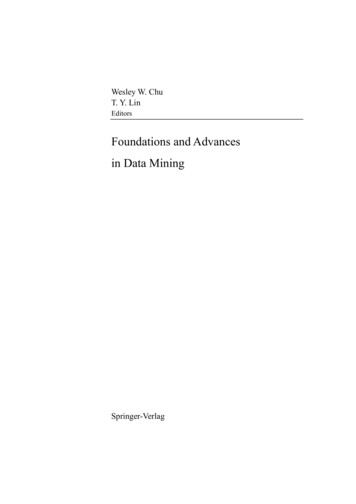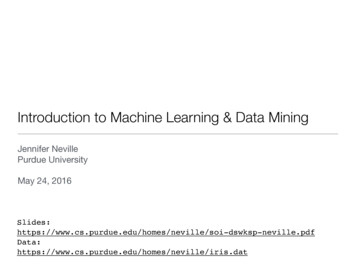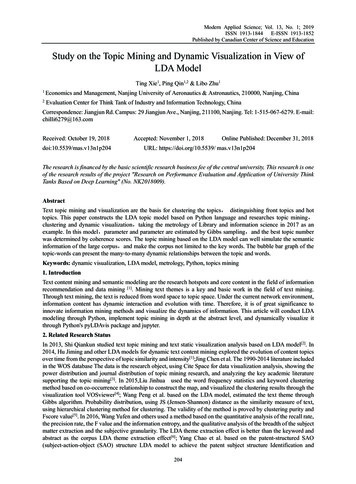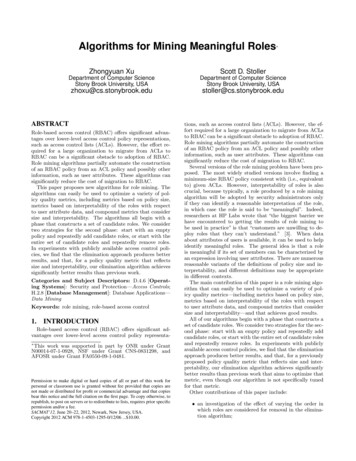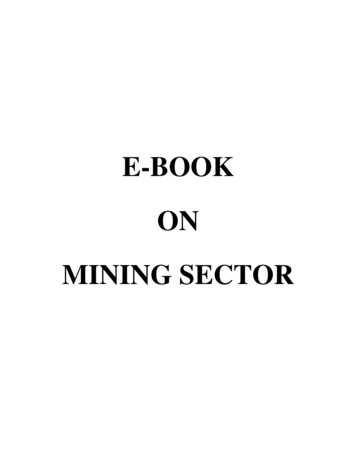
Transcription
E-BOOKONMINING SECTOR
ucture of Minerals and Mining Sector02-033.0Role of Mining Sector in Indian Economy03-064.0Legislative Framework for Mining Sector06-125.0Initiatives/New Development for Mining Sector12-176.0Mineral Administration17-187.0Mineral Regulation18-198.0Taxation and Royalties19-219.0Present Status of Exploration with Mineral Assets21-3010.0Distribution of Mining Leases in the Country30-3211.0Mineral Production32-3612.0Consumption of Minerals and Mineral Based Industries36-3913.0Foreign Trades39-411
ANNEXURESNos.DetailsPagesIProduction of Selected Minerals, 2010-11 to 2014-15 (E)42IIMineral wise no. of Reporting Mines for MCDR Minerals, 2009-10 to442013-14 (P)III (A)State wise Average Daily Employment, 2011-12 to 2013-14 (P)46III (B)Mineral wise Average Daily Employment, 2011-12 to 2013-14 (P)47IV (A)Contribution and Rank of India in World Production of Principal Minerals49& Metals, 2013IV (B)Degree of Self Sufficiency in Principal Minerals & Metals, 2013-14 (P)50VMineral wise reserves/resources as on 1.4.2010/*201351VI (A)State wise Summary of Mining Lease distribution as on 31.3.201455VI (B)Mineral wise Summary of Mining Lease distribution as on 31.3.201456VIIMineral wise production & Value, 2009-10 to 2013-14 (P)58VIIIConsumption of Important Minerals, 2011-12 to 2013-14 (P)59IX (A)Exports of Ores & Minerals, 2010-11 to 2014-15 (P)60IX (B)Exports of Metals & Alloys, 2010-11 to 2014-15 (P)62X (A)Imports of Ores & Minerals, 2010-11 to 2014-15 (P)63X (B)Imports of Metals & Alloys, 2010-11 to 2014-15 (P)662
1.0INTRODUCTIONIt is a well known ecological fact that the best known forests, river and ocean basins, and fertilelandscapes are also rich below ground with natural resources such as fossil oils and minerals. Mining ofunderground natural resources do require giving up the rights and usufruct benefits of surface basednatural resources. Added to this is the fact that the history of the world has seen a continual modificationand mortification of the landscape of the earth both above and underground for anthropocentric purposes;and most of such land conversions are irreversible.India has a total geographical area of about 328 million hectares. Of this, the mining lease (exceptthan fuel, atomic and minor minerals) area as on 31.3.2014, constitutes around 0.14 percent. The Indiansub-soils are rich in onshore and off shore crude oils and gas, coal, iron ore, copper, bauxite, etc. Of allvariety of land use categories, the common lands consisting of forest lands, pasture lands, and currentfallow and cultural waste lands dominate.Minerals are valuable natural resources that are finite and non-renewable. They constitute thevital raw materials for many basic industries and are a major resource for development. The history ofmineral extraction in India dates back to the days of the Harappan civilization. The wide availability ofminerals in the form of abundant rich reserves and the eco-geological conditions make it very conducivefor the growth and development of the mining sector in India. As a major resource for development theextraction and management of minerals has to be integrated into the overall strategy of the country‟seconomic development. The exploitation of minerals has to be guided by long-term national goals andperspectives. Thus, minerals play a key role in the evolution of human society and the development ofleading economics.Mining sector, being one of the core sector of economy, provides basic raw materials to manyimportant industries like power generation (thermal), iron and steel, cement, petroleum and natural gas,petro-chemicals, fertilisers, precious & semi-precious metals/stones, electrical & electronics equipment,glass and ceramics etc. India produces as many as 88 minerals which includes 4 fuels minerals, 3 atomicminerals, 26 metallic & non-metallic minerals and 55 minor minerals (including building and othermaterials). There will be huge demand for minerals in view of the rapid urbanization and growth in themanufacturing sector in India. India occupies a dominant position in the production of many mineralsacross the globe.3
2.0STRUCTURE OF MINERALS AND MINING SECTORThe Ministry of Mines (MoM), Government of India is responsible for the entire minerals andmining sector in the country that includes legislation, administration, policy formulation etc. in respect ofall mines and minerals other than coal and lignite, natural gas and petroleum, but including offshoreminerals. In the case of atomic minerals and coal activities of the Ministry are limited to regionalexploration. In India, the minerals are classified as minor minerals and major minerals. The power toframe policy and legislation relating to minor minerals is entirely delegated to the State Governmentswhile policy and legislation relating to the major minerals is dealt by the MoM. The Ministry isresponsible for the administration of the Mines and Minerals (Development and Regulation) Act, 1957and rules made there under in respect of all mines and minerals other than coal, natural gas andpetroleum. MoM through its attached office, Geological Survey of India (GSI), facilitates exploration,geological mapping and mineral resource assessment in the country. Indian Bureau of Mines (IBM), asubordinate office of the MoM is mainly responsible for regulation of mining in the country. The Ministryalso administers the Offshore Areas Mineral (Development and Regulation) Act, 2002 and rules madethere under. Mineral concessions in India are granted to Indian nationals or entities incorporated in Indiaonly.2.1Subjects allocated to Ministry of Mines(a) Legislation for regulation of mines and development of minerals within the territory of India,including mines and minerals underlying the ocean within the territorial waters or the continental shelf, orthe exclusive economic zone and other maritime zones of India as may be specified, from time to time byor under any law made by Parliament.(b) Regulation of mines and development of minerals other than coal, lignite and sand for stowing andany other mineral declared as prescribed substances for the purpose of the Atomic Energy Act, 1962 (33of 1962) under the control of the Union as declared by law, including questions concerning regulation anddevelopment of minerals in various States and the matters connected therewith or incidental thereto.(c) All other metals and minerals not specifically allotted to any other Ministry / Department, such asaluminium, zinc, copper, gold, diamonds, lead and nickel.(d) Planning, development and control of, and assistance to, all industries dealt with by the Ministry.(e) Administration and management of Geological Survey of India.(f) Administration and management of Indian Bureau of Mines.(g) Metallurgical Grade silicon4
2.2Attached Office / Subordinate Office: Geological Survey of India (Headquarters at Kolkata) is an attached office and Indian Bureau of Mines (Headquarters at Nagpur) is a subordinate office of the Ministry.2.3Public Sector Undertakings:There are three Public Sector Undertakings under the Ministry of Mines, namely: National Aluminium Company Limited (NALCO), Bhubaneswar Hindustan Copper Limited (HCL), Kolkata Mineral Exploration Corporation Limited (MECL), Nagpur2.4Autonomous BodiesThere are three Research Institutions which are Autonomous Bodies of this Ministry:3.0 Jawaharlal Nehru Aluminium Research Development and Design Centre (JNARDDC), Nagpur; National Institute of Rock Mechanics (NIRM), Kolar Gold Fields, Karnataka, and National Institute of Miners‟ Health (NIMH), Nagpur.ROLE OF MINING SECTOR IN INDIAN ECONOMYMining is one of the core sectors that drive growth in an economy. Not only does it contribute toGDP, it also acts as a catalyst for the growth of other core industries like power, steel, cement, etc.,which, in turn, are critical for the overall development of the economy. Thus, mining sector is playing acritical role in the economic development, attracting investment and generating employment in thecountry.Mining sector provides basic raw materials to many important industries like (thermal) powergeneration, iron and steel, cement, petroleum and natural gas, petro-chemicals, fertilisers, precious andsemiprecious metals and stones, electrical and electronic equipments, glass and ceramics etc. It accountsfor 18% (9.4% share in exports of ores and minerals and 8.8% share in export of metals & alloys) inexport earnings of the country.Indian economy GDP grew by 7.3% in 2014-15 and is expected to grow at higher rate in thecoming year. Mining sector contributed about 2.85% of the GVA (at current prices) in 2013-14 and2.39% in 2014-15 as per the new series data released by CSO. The average daily employment in mines5
(excluding atomic and minor minerals) is estimated at 5.31 lakhs during 2013-14. In respect of mineralscovered under MCDR, the average daily employment is 1.31 lakhs and that for iron ore it is 0.38 lakhs.Amongst the minerals covered under MCDR, iron ore is the top contributor in the GVA ofmining and quarrying sector, followed by chromite, limestone etc. Amongst the minerals covered underMCDR, the major mineral rich states are Odisha, Chhattisgarh, Rajasthan, Karnataka, Jharkhand etc.India has exported ore & minerals and metal & alloys during 2014-15(p) for Rs.1,78,077 Croresand Rs.1,67,120 Crores, respectively. During same period, India has also imported ore & minerals andmetal & alloys during 2014-15(p) for Rs. 10,71,689 Crores and Rs. 4,01,259 Crores, respectively.Total Value of Export & ImportsItem(In Rs. Crore )ImportsExportsOres & MineralsMetals & 14(P)12158273213562014-15(P)1071689401259Source: DGCIS, Kolkata; R: Revised; P: Provisional3.1Index of Mineral ProductionBased on the overall trend so far the index of mineral production (base 2004-05) for the year2014-15 is estimated to be 127.7 as compared to 124.7 for 2013-14 showing a positive growth of 2.4%.3.2Value of Mineral ProductionThe total value of mineral production (excluding atomic minerals) during 2014-15 has beenestimated at Rs. 2,67,637 crore, which shows a decrease of about 3.78% over that of the previous year.During 2014-15, estimated value for fuel minerals account for Rs. 1,71,014 crore or 63.90%, metallicminerals, Rs. 36,773 crore or 13.74% of the total value, non-metallic minerals, Rs. 52,490 crore or19.61% of the total value and minor minerals, Rs. 7,360 crore or 2.75% of the total value.The value of production of selected minerals other than atomic mineral during 2010-11 to 201415 (E) is given in Annexure I.3.3Gross Domestic Product from Mining & Quarrying SectorThe GVA accrued from mining and quarrying sector at current prices for 2014-15 is provisionallyestimated at Rs. 2,75,812 crore. Contribution of mining and quarrying (at current prices) in total GVAwas 2.39% during 2014-15. Contribution of mining and quarrying (at current prices) in total GVA during2011-12 to 2014-15 is given below6
Contribution of Mining & Quarrying (at Current Prices) in total GVAS. N.123ParameterGVA (All Sector)GVA (Mining & Quarrying*)% Share of Mining &Quarrying in GVA2011-12(NS)81955462628133.21(In Rs. crore)2012-13(NS) 2013-14(NS) 123.082.852.39(NS): New Series, (PE): Provisional Estimate; Source: CSO3.4Mining (Reporting Mines)Indian mining industry is characterized by a large number of small operational mines. Reportingmine is defined as “A mine reporting production or reporting „nil‟ production during a year but engagedin developmental work, such as, overburden removal, underground driving, winzing, sinking work,exploration by pitting, trenching or drilling as evident from the MCDR returns”. The number of mineswhich reported mineral production (excluding minor minerals, petroleum (crude), natural gas and atomicminerals) in India was 3318 in 2014-15 as against 3722 in the previous year. Out of 3318 reporting mines,498 were located in Rajasthan followed by Andhra Pradesh (444), Gujarat (362), Madhya Pradesh (326),Tamil Nadu(272), Jharkhand (250), Chhattisgarh(201), Karnataka (178), Odisha (173), Maharashtra(150), Telangana (145) and West Bengal (120). These 12 States together accounted for 94% of totalnumber of mines in the country in 2014-15. Among them, 575 mines belonged to coal & lignite, 595 tometallic minerals and 2,148 to non-metallic minerals.Number of Reporting MinesSectorAll Minerals*Coal (including Lignite)Metallic MineralsNon-Metallic 4842014-15(E)33185755952148*Excluding atomic minerals, petroleum (crude), natural gas (utilized) and minor minerals.Source: Annual Report, 2014-15, Ministry of Mines.Mineral wise no. of reporting mines for minerals (excluding fuel, atomic and minor minerals)during 2011-12 to 2013-14 is given in Annexure - II.3.5EmploymentDuring 2013-14(p), about 1,31,455 persons were employed in mining sector (excluding atomicand minor minerals). State wise and mineral wise average daily employment during the period 2011-12 to2013-14(p) is given in Annexure-III (A) & (B).7
3.6Self-Reliance in Minerals & Mineral Based ProductsIndia‟s ranking in 2013 as compared to world production was 2nd in barytes, Chromite, andTalc/Steatite/Pyrophyllite, 3rd in Coal & Lignite and Zinc (slab), 4th Iron ore, Kyanite/Andalusite/Sillimanite, and steel (crude/liquid), 5th in Bauxite ore, 6th in Manganese ore, 7th Aluminium and 10th inCopper (refined). The contribution and rank of India in world production of principal minerals & metalsin 2013 are given in Annexure – IV (A).India continued to be wholly or largely self-sufficient in minerals which constitute primarymineral raw materials to industries, such as, thermal power generation, iron & steel, ferro-alloys,aluminium, cement, various types of refractories, etc. India is, by and large, self-sufficient in coal (withthe exception of very low ash coking coal required by the steel plants) and lignite among mineral fuels;bauxite, chromite, iron and manganese ores, etc. among metallic minerals; and almost all the industrialminerals with the exception of chrysotile asbestos, borax, fluorite, kyanite, potash, rock phosphate andelemental sulphur. Despite high degree of self-sufficiency, some quantities of various minerals/ores areimported due to economic consideration or requirement of specific grade to meet the demand for eitherblending with locally available mineral raw materials and/or for manufacturing special qualities ofmineral-based products. To meet the increasing demand of uncut diamonds, emerald and other preciousand semiprecious stones by the domestic cutting and polishing industry, India continued to depend onimports of raw uncut stones for their value-added re-exports.The degree of self-sufficiency in respect of principal minerals & metals in 2013-14 is given inAnnexure – IV (B).4.0THE LEGISLATIVE FRAMEWORK FOR MINING SECTORIndia‟s mineral and mining sector operates under a federal structure wherein the Central Govern-ment formulates the legislation for all minerals except the minor minerals and the State Governmentsformulate legislation for minerals classified as minor minerals. India has written legal and constitutionalframework to manage the mineral sector. National Mineral Policy provides the direction for mineralsector. Management of mining sector is the responsibility of the Central Government and the StateGovernments. The Constitution bestows power to the Parliament to enact legislation relating to themining and the States are bound by the Central legislation.In the federal structure of India, the State Governments are the owners of minerals located withintheir respective boundaries. The Central Government is the owner of the minerals underlying the oceanwithin the territorial waters or the Exclusive Economic Zone of India.8
In this context, the entry at serial No. 23 of List II (State list) to the Constitution of India states,„Regulation of mines and mineral development subject to the provisions of List I with respect toregulation and development under the control of the Union.‟ The entry at serial No. 54 of List I (Centrallist) to the Constitution of India states, „Regulation of mines and mineral development to the extent towhich such regulation and development under the control of the Union is declared by Parliament by lawto be expedient in the public interest.‟In pursuance to the entry at serial No. 54 of List I, the Central Government have framedlegislation titled Mines & Minerals (Development and Regulation) (MMDR) Act, 1957 as Central Act forgoverning the Mineral Sector (other than Petroleum and Natural Gas) of the Country. The MineralConcession Rules, 1960 and the Mineral Conservation and Development Rules, 1988 are the rules framedunder MMDR, 1957 to develop and regulate mining sector.The State Governments, as owners of onshore minerals, grant mineral concessions and collectroyalty, dead rent and fees as per the provisions of MMDR Act, 1957. The MMDR Act, 1957 recognisesa substantial role for the State Governments. In exercise of powers under section 3 (e) of the MMDR Act,1957, the central government notifies „minor minerals‟. As per Section 15 of the MMDR Act, 1957 StateGovernments have complete powers for making rules for grant of concessions in respect of minorminerals; and levy and collection of royalty on minor minerals. In the case of major minerals, Statessubstantially regulate and develop minerals subject to provisions of the Act. Further, as per section 23C ofMMDR Act, 1957, State Governments have complete powers to make rules for prevention of illegalmining and for purposes connected therewith. Therefore, matters relating to regulation of mining andcontrol of illegal mining of minor minerals are all matters which lie in the domain of State Governments.The Central Government retains the power of revision, fixation of royalty etc. in respect of majorminerals. The Ministry of Coal exercises all powers of the Central Government with respect to Coal andLignite under the Act. The Department of Atomic Energy similarly exercises all powers for AtomicMinerals. In order to regulate the mining and development of minerals in the offshore area, the Parliamenthas enacted the “Offshore Areas Minerals (Development and Regulation) Act, 2002”. The Act empowersthe Central Government to grant mineral concessions for offshore areas and collect royalty. The MinesMinistry administers the OAMDR Act, 2002 and the rules made there under, for all minerals, other thanPetroleum and Natural Gas within the territorial waters and the continental shelf. The Indian Bureau ofMines has been notified as the administrative authority for concession management of offshore areas.9
A.Mineral Concession Rules (MCR), 1960The MCR, 1960 defines the process of grant of mineral concessions as per the provisions of Sec-tion 13 of the MMDR Act, 1957. The rules lay down the process and timelines for grant of concessions,disposal and refusal of applications and the basic conduct of accounts, registers and information reports.B.Mineral Conservation & Development Rules (MCDR), 1988The MCDR, 1988 prescribes guidelines for the conservation and development of minerals as perthe provisions of Section 18 of the MMDR Act, 1957. The rules prescribe procedures for carrying outprospecting and mining operations and the general requirements relating to preparation of mining andprospecting plans and filing of notices and returns. The rules also cover guidelines for protection of theenvironment.C.Minor Mineral Concession RulesVarious State Governments have prescribed rules for the grant of mineral concessions in respectof minerals classified as minor minerals under the MMDR Act, 1957.D.Offshore Areas Mineral (Development & Regulation) Act, 2002The Offshore Areas Mineral (Development and Regulation) Act, 2002, provides for developmentand regulation of mineral resources in the territorial waters, continental shelf, exclusive economic zoneand other maritime zones of India and to provide for matters connected to it.E.Offshore Areas Mineral Concession Rules, 2006The Offshore Areas Mineral Concession Rules, 2006, lay down the process for grant and renewalof reconnaissance permits, exploration licenses and production leases as per provisions of Section 35 ofthe Offshore Areas Mineral (Development and Regulation) Act, 2002. The rules prescribe for measuresfor protecting the marine environment and safety measures to be followed in the leased area. The rulesalso define the operational guidelines for each concession granted under the act.F.Granite Conservation and Development Rules, 1999 & Marble Development andConservation Rules, 2002These rules were framed under Section of 18 of the MMDR Act, 1957 for conservation andsystematic development of granite and marble resources in the country, respectively.10
4.1National Mineral PolicyPrior to 1993, the mineral sector was guided by the Industrial Policy Resolution of 1953. Inpursuance of the reforms initiated by the Government of India in fiscal, industrial and trade regimes, thefirst National Mineral Policy was enunciated in March, 1993 which ushered in liberalization in the miningsector. The National Mineral Policy recognized the need for encouraging private investment includingForeign Direct Investment (FDI), and for attracting state-of-art technology in the mineral sector. Thepolicy stressed that the Central Government, in consultation with the State Governments, shall continue toformulate legal measures for the regulation of mines and the development of mineral resources to ensurebasic uniformity in mineral administration so that the development of mineral resources keeps pace, andis in consonance with the national policy goals.Mining is a three-stage operation, involving regional exploration, detailed exploration, and actualmining. Regional exploration is mainly a survey activity to identify areas bearing mineral deposits.Detailed exploration is a little more invasive and can involve close spaced drilling (depending on themineral) and substantial testing to establish commercially exploitable ore bodies. Mining projects,therefore, have a long gestation period requiring large investments in exploration and other developmentactivities before commercial production can begin, and are thus considered as a high risk venture for thereason that a prospector‟s investment may or may not result in finds of commercially exploitable deposits.In India, investment has been lacking in such high-risk ventures and the exploration done by GeologicalSurvey of India (GSI) continues to be the main basis for investment in mining.Minerals are a valuable natural resource being the vital raw material for infrastructure, capitalgoods and basic industries. As a major resource for development the extraction and management ofminerals has to be integrated into the overall strategy of the country‟s economic development. Theexploitation of minerals has to be guided by long-term national goals and perspectives. Just as these goalsand perspectives are dynamic and responsive to the changing global economic scenario so also thenational mineral policy has to be dynamic taking into consideration the changing needs of industry in thecontext of the domestic and global economic environment. It is, therefore, necessary to revisit theNational Mineral Policy, 1993.In the mid-term appraisal of the Tenth Five-year Plan, it was observed that the main factorsresponsible for lack of adequate investments into the mineral sector were procedural delays in processingof applications for mineral concessions and absence of adequate imfrastructure in the mining areas. Asrecommended in the mid-term appraisal of Xth five year plan, the Planning Commission constituted aHigh Level Committee (HLC) under the Chairmanship of Shri Anwarul Hoda, Member PlanningCommission. Further, based on the recommendations of the High Level Committee set up in the Planning11
Commission, Government of India, in consultation with State Governments, the National Mineral Policy(NMP) was notified on the 13th March, 2008.4.2National Mineral Policy, 2008The National Mineral Policy (NMP) was notified in 2008. It recommends measures like assuredright to next stage mineral concession, transferability of mineral concessions and transparency inallotment of concessions, in order to reduce delays which are seen as impediments to investment andtechnology flows in the mining sector in India. The Mineral Policy also seeks to develop a SustainableDevelopment Framework for optimum utilisation of the country‟s natural mineral resources for theindustrial growth in the country and at the same time improving the life of people living in the miningareas, which are generally located in the backward and tribal regions of the country. Other features of theNational Mineral Policy, 2008, inter alia, are:(a) NMP recognizes that minerals are valuable natural resources being the vital raw material forinfrastructure, capital goods and basic industries, and therefore development of the extraction andmanagement of minerals has to be integrated into the overall strategy of the country‟s economicdevelopment.(b) The exploitation of minerals has to be guided by long-term national goals and perspectives which aredynamic and responsive to the changing global economic scenario.(c) The NMP also recognizes that the country is blessed with ample resources of a number of mineralsand has the geological environment for many others, being a part of the ancient Gondwana land whichcomprised parts of Australia, Africa and Latin America.(d) NMP lays out that the guiding strategy for development of any mineral should naturally keep in viewits ultimate end use in terms of demand and supply in the short, medium and long terms and this would bemarket oriented. However, a disaggregated approach in respect of each mineral should be adopted and amineral specific strategy be developed to maximize gains from the comparative advantage which thecountry enjoys, and mineral development be prioritized in terms of import substitution, value addition andexport, in that order.(e) Conservation of minerals shall be construed not in the restrictive sense of abstinence fromconsumption or preservation for use in the distant future but as a positive concept leading to augmentationof reserve base through improvement in mining methods, beneficiation and utilisation of low grade oreand the rejects and recovery of associated minerals.12
Important areas of focus in National Mineral Policy 2008The Policy states that the Central Government in consultation with State Governments shallformulate legal measures necessary for giving effect to it to ensure basic uniformity in mineraladministration across the country, to ensure that the development of mineral resources keeps pace, and isin consonance with the national goals. Some of the important areas of focus in the National MineralPolicy 2008 are:(i) Ushering in greater liberalization and private sector involvement, and to widen the scope of theregulatory framework of the Government in the mining sector by shifting the focus from conventionalareas of managing the mineral concession systems to new areas of regulating the mineral sectorholistically through addressing issues of simplification, transparency and sectoral best practices in orderto attract capital and technology in the sector from new sources.(ii) Developing partnerships with stakeholders including the State Governments, mineral and mineralbased industries and various concerned Ministries/Departments of the Central Government, fordevelopment and conservation of mineral resources and formulation of strategy to ensure raw materialsecurity. The policy also seeks to deepen the scope of the developmental framework by mandating bettermanagement of resources, enhancing the impetus on Research and Development, as also by developingthe Human Resources in the sector.(iii) Ensuring that the interests of host populations and other vulnerable sections are fully protected andthe benefit of the economic activity in the mining sector flows equitably to the stakeholders.NMP, 2008 has also deepened the scope of the developmental framework by mandating bettermanagement of resources and improving the Research and Development and Human Resources in thesector to ensure that the interests of host populations and other vulnerable sections are fully protected andstakeholders interests are developed, and the benefit of the economic activity in the mining sector flowequitably to the stakeholders.4.3Foreign Direct Investment policy for Mining sectorGovernment of India permits 100% Foreign Direct Investment (FDI) in exploration, mining,mineral processing and metallurgy through the automatic route, by way of equity participation in acompany incorporated in India, for all non-fuel and non-atomic minerals including diamonds and preciousstones.13
Mining and mineral separation of titanium-bearing minerals and ores, its value addition andintegrated activities fall under the government route of foreign direct investment up to 100%. FDI in coalmining is allowed for captive consumption only.5.0INITIATIVES/NEW DEVELOPMENTS FOR MINING SECTOR5.1MINING TENEMENT SYSTEM (MTS)The MTS has been envisaged to automate the various processes associated with the mineralconcession regime. The objective of the Scheme is to develop an online National Mineral InformationSystem for investors by linking Central and State organizations engaged in administration of mineralresources in the country. The Mining Tenement System (MTS) would have graphical informationdatabase (GIS) as well as information in textual form.These two databases, i.e., non-special database and special database would be seamlesslyintegrated so as to r
E-BOOK ON MINING SECTOR . 1 CONTENTS Nos. Details Pages 1.0 Introduction 01-01 2.0 Structure of Minerals and Mining Sector 02-03 3.0 Role of Mining Sector in Indian Economy 03-06 4.0 Legislative Framework for Mining Sector 06-12 5.0 Initiatives/New Development for Mining Sector 12-17 . 2.39% in 2014-15 as


